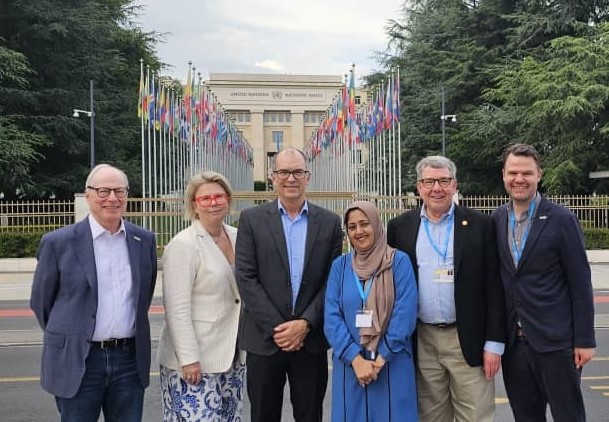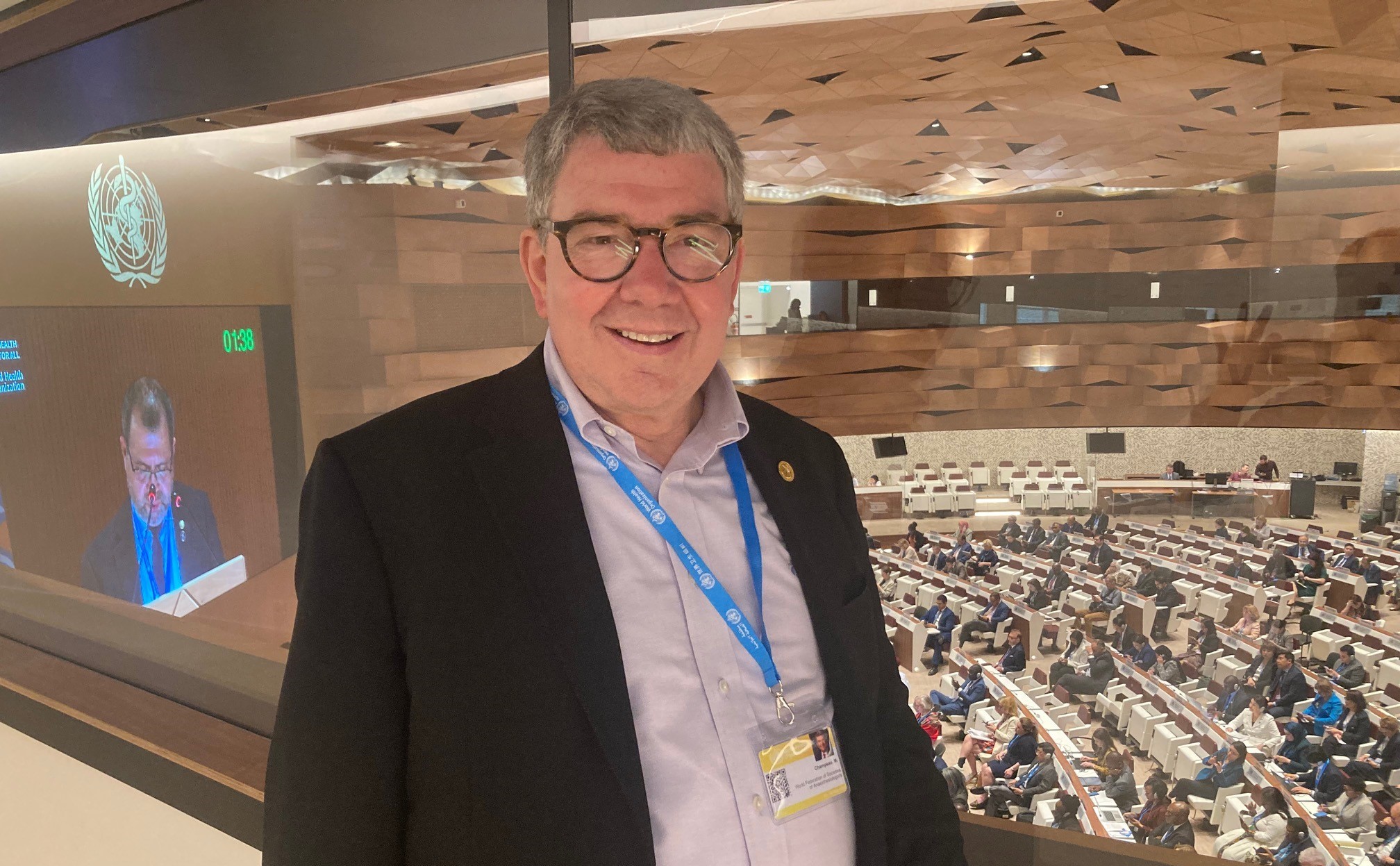In May, Dr Michael Champeau, the President of the American Society of Anesthesiologists (ASA) joined the WFSA delegation for the 76th World Health Assembly(WHA). Participation at the WHA formed part of a broader trip to build on ASA’s partnerships worldwide. Dr Champeau highlights some of the key activities and learnings from his travels.
International Collaboration I—World Health Assembly (WHA)
In late May, the World Health Assembly held its 76th meeting at the Palais de Nations, in Geneva, Switzerland. By way of background, the WHA is the governing body of the World Health Organization (WHO), which is, in turn, the technical health agency of the United Nations. The WHO has a broad mandate to act as a coordinating authority on international health issues and is comprised of 194 Member States. It also includes 218 “non-state actors” who are in “official relations” with the organization. Importantly for anesthesiology, the World Federation of Societies of Anesthesiologists (WFSA) is one of those non-state actors, and, as a result, our voice in the WHA.
That voice is crucial. You may recall that in 2018, the WHO and WFSA joined to issue their “International Standards for a Safe Practice of Anesthesia”. Included in their HIGHLY RECOMMENDED standards, which they considered the functional equivalent of mandatory standards, is that “Wherever and whenever possible, anesthesia should be provided, led, or overseen by an anesthesiologist. When anesthesia is provided by non-anesthesiologists, these providers should be directed and supervised by anesthesiologists, in accordance with their level of training and skill.” The statement provides powerful support for our advocacy here at home.

Michael Champeau and Francis Peel.
We all owe a debt of gratitude to WFSA Immediate Past President Adrian Gelb and current President Wayne Morriss for their work shepherding that statement through the WHO bureaucracy. It should be noted that the International Federation of Nurse Anesthetists is not a “non-state actor in official relations with WHO” and therefore—unlike WFSA—cannot make statements before the WHO Executive Board or at WHA.
The WHA meetings include not only the formal meetings of the Assembly in the Palais, but also a number of so-called side events and roundtables. These can focus on a wide range of health topics. The overstretched global health care workforce and its reliance on women, who represent more than 67% of worldwide health care providers, were recurring themes at the side events and roundtables this year.
In an upcoming article for the ASA Monitor, WFSA’s Communications and Advocacy Manager Francis Peel draws attention to the late global health champion Paul Farmer’s adage that “surgery is the neglected stepchild of global public health”. It’s a perfect description of the uphill struggle anesthesia and surgery advocates can have getting their voices heard at the World Health Assembly.
Accordingly, it’s not surprising that the most important issue at this year’s meeting from an anesthesiology perspective was the ECO (Emergency, Critical, Operative) Resolution, proposed by Brazil, Ethiopia, the European Union, Kenya, and Paraguay calling for timely global efforts to embed quality emergency, critical, and operative care services as an integral part of comprehensive primary health care. Robust, integrated ECO services are foundational to national health systems, and to the capacity to respond effectively to emergency events. The WFSA, along with various surgical groups, strongly supported the proposal, which elevates the profile of anesthesia care, with President Wayne Morriss of New Zealand testifying on the floor of the Assembly on behalf of the specialty.
The Member States also endorsed a resolution recognizing the critical role of medical oxygen (PDF) for treatment of hypoxemia, in particular for surgery and trauma care. Many health facilities in lower-resourced settings lack uninterrupted access to medical oxygen, resulting in preventable deaths – especially during the COVID-19 pandemic, when the need for medical oxygen outstripped the capacities of many health systems.
Although oxygen has been included on the WHO Model List of Essential Medicines (EML) since 1979, the resolution calls attention to the fact that medical oxygen generation and distribution requires a specialized infrastructure. The new resolution urges Member States to set up, as appropriate, national and regional medical oxygen systems in order to secure the uninterrupted provision of medical oxygen to health care facilities at all levels.
We should all pause once in a while to reflect on how fortunate we are compared to many of our international colleagues and their patients.
International Collaboration II—European Society of Anaesthesiology and Intensive Care (ESAIC)
In early June, the European Society of Anaesthesiology and Intensive Care held its annual meeting in Glasgow, Scotland. (Note the name change made a couple of years ago from the European Society of Anaesthesiology). During the opening ceremony, ESAIC President Edoardo De Robertis (Italy) specifically cited the importance of the cooperation that led to the publication, during the meeting itself no less, of the joint letters to the editors of Anesthesiology and the European Journal of Anaesthesiology from ASA and ESAIC leaders.
The letters called attention to the recently promulgated guidelines on the management of neuromuscular blockade, coincidentally published by both societies last autumn. Edoardo approached me earlier this spring suggesting the joint letters to emphasize the fact that the two societies, working completely independently of one another, had developed almost identical guidelines. We both thought the unusual circumstances called attention to the importance of the guidelines and strengthened the rationale underlying the recommendations in them. We thank the editors of both journals for their cooperation.
International Collaboration III—Association of Anesthetists of Great Britain and Ireland (AAGBI)/Royal College of Anesthetists (RCA)
Thirdly, driven by recent studies, the evolving nature of the disease and the widespread vaccination of Americans against COVID-19, ASA and the Anesthesia Patient Safety Foundation (APSF) last week released a joint statement providing updated recommendations for the timing of elective surgeries and anesthesia for patients after a COVID-19 infection.
The recommendations follow guidelines released the same day by the Association of Anesthetists of Great Britain and Ireland and the Royal College of Anesthetists. In light of recent studies, ASA and APSF had been working with our British colleagues to assess and align our recommendations for scheduling a procedure after a patient has had COVID-19. As the disease evolves and becomes less virulent, and as increasing numbers of the population have either been vaccinated, exposed or both, these recommendations help provide guidance on balancing the risk of delaying surgery against the risk of complications.
APSF’s President Dan Cole and Board member Della Lin, the ASA Executive Committee, and ASA Chief Quality Officer Matt Popovich had extensive conversations with Kariem El-Boghdadly, MBBS, Featherstone Professor at the AAGBI, the principal author of their recommendations and one of the editors of Anaesthesia, in arriving at the decision to support the British guidelines. We thought that deviation between the recommendations would only confuse practitioners and saw this as another opportunity to collaborate with international colleagues.
The guidance states that elective surgeries should be performed only after patients have clinically recovered from COVID-19 infection and, even then, only when the anesthesiologist, surgeon or proceduralist and patient together agree to proceed. The decision should be based on whether the patient is infectious and, if not, the health professionals’ opinions regarding the appropriate time to wait between recovery from COVID-19 and the surgery, based on patient and surgery-specific risks. Elective procedures should be deferred until at least two weeks have elapsed since the infection; the decision to proceed between two and seven weeks after infection should be based on an individualized risk assessment, taking into account the severity of the infection, co-morbidities and the extent of physiologic trespass associated with the procedure.
The joint statement also notes that these revised recommendations do not diminish the significance of COVID-19 or the effects that an infection may have on individual patients.
All three of these updates show the importance and advantages of remaining engaged with our global anesthesia community.
Republished, with permission, from ASA Monday Morning Outreach (26 June 2023).






